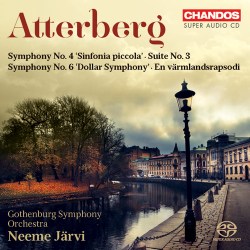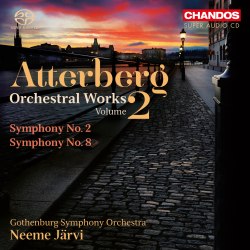|


|
Kurt ATTERBERG (1887-1974)
Symphony No.6, Op. 31, Dollar Symphony [27:12]
En värmlandsrapsodi, Op. 36 [7:57]
Suite No. 3, Op. 19 No. 1 [14:30]
Symphony No. 4, Op. 14, Sinfonia piccola [19:59]
Suite soloists: Sara Trobäck Hesselink (violin); Per Högberg (viola)
Gothenburg Symphony Orchestra/Neeme Järvi
rec. 31 May - 8 June 2012, Concert Hall, Gothenburg, Sweden
CHANDOS SACD CHSA5116 [70:14]
Symphony No. 2 in F, Op. 6 [31:27]
Symphony No. 8 in E minor, Op. 48 [29:45]
Gothenburg Symphony Orchestra/Neeme Järvi
rec. 14-17 January 2013, Concert Hall, Gothenburg, Sweden
CHANDOS SACD CHSA5133 [61:12]
Neeme Järvi’s continuing Atterberg symphony cycle is frustrating in a way that sums up Järvi’s entire career. It both promotes and trivializes little-known music by treating it to proficient, skilled, soulless performances. An Atterberg album is a strange place for a music critic to take a firm stand, but I’m afraid I have a lot to say.
Kurt Atterberg was one of the great romantic composers who got away, born too late for the era he belonged in and the acclaim he deserved. Although some of his works are not great, a few truly are. No. 8, recorded here, for example: Atterberg took folksy Swedish tunes and wove them together carefully into a cyclical “tragic symphony.” His Fifth is another tragedy, with an astonishing finale that is capped by a “death-waltz,” like a Strauss waltz’s vindictive, bitter twin. The Third Symphony, by contrast, ends in some of the most purely beautiful romantic language ever composed. The Fourth Symphony, an ultra-concise piece lasting less than twenty minutes, packs maximum flavor into its bite-size servings.
Atterberg’s greatest triumph was also his greatest defeat. In 1928, he submitted the Sixth Symphony to the International Columbia Graphophone Competition, a massive international contest in which a panel of a dozen prominent composers, musicians, and critics selected the best new symphony, to be recorded by Arturo Toscanini. Atterberg’s symphony was deliberately silly, almost a pastiche; he made light of the competition by intentionally writing the most absurd possible finale. Choosing a childish theme, he put it through wacky paces - including a bullying rival tune played by a swaggering brass band - before ending the piece with a cadenza for cymbals, snare drum and glockenspiel.
Atterberg stayed at home for the results banquet and was shocked to read in the newspapers that he had won. Worse, the musical establishment failed to pick up on the joke and decided that his symphony was the work of a simpleton. The Toscanini recording got made, and everyone outside Sweden collectively decided to take the composer off their radar.
So far as I know, Neeme Järvi is the first conductor to play the Sixth faster than Toscanini did. His Gothenburg Symphony is up to the challenge, and their playing in the fast movements is frankly thrilling. They are like a flawlessly designed machine, stunningly efficient and unfailing. The same feeling prevails in the finale of the Eighth, although in the first movement of that symphony Järvi purposely reins them in, softens the tone, and makes everything cutesy rather than dramatic. The brief Värmland Rhapsody gets a lovely performance, as does the Suite for violin, viola and orchestra, although there are at least two other fine recordings of this petite, charming piece.
But where is the soul? The Sixth Symphony has a glorious slow movement, a little too sincere for Atterberg’s otherwise jokey piece and clearly far too sincere for modernist music critics of the 1930s. Järvi speeds through it like he doesn’t believe in it, or perhaps is late for lunch. The Eighth’s adagio is one of the best things Atterberg ever wrote, a haunting long English horn song full of atmosphere and heartbreak that returns in powerful full-orchestra fashion for the symphony’s emotional climax. Järvi trivializes everything here, by speeding into the main melody, with a harshly clipped flute accompaniment, and presenting it airily as if to say, “here’s another one of those folk tunes”.
Granted, this is a symphony of folk tunes. But Atterberg intended for it to be more than that. He is quoted extensively in the booklet notes to that effect. He turned a drinking song into “a powerful tragic symphonic theme, and I think that my interpretation can be defended.” He positioned himself as a successor to Mahler’s rustic dances, Haydn’s Hungarian trios, and Dvořák’s New World Symphony.
As proof, there’s the big ending of No. 8. After a suspenseful build reusing the slow movement’s introduction, Atterberg reveals the symphony’s two main themes in counterpoint to one another, proving in a dramatic flourish that the entire work stems from one central idea and bringing that idea to a grand conclusion. Järvi is unimpressed. He has the trumpet play one of those two themes so timidly that it seems to be a deliberate denial of the work’s power. He also has everybody rushing along so quickly that the moment doesn’t resonate at all.
It is no surprise that Järvi treats Atterberg this way. He treats almost every composer this way. His lack of empathy contaminates his Chabrier album (my colleague Dan Morgan says “incidental charm and colouristic touches barely register”), his Saint-Saëns (my 2012 review seems never to have been published: “missing the last degree of romantic passion”), his Suppé (my colleague John Sheppard notes “lack of commitment”), his Tchaikovsky ballets (Nick Barnard was “hugely disappointed”), his Tchaikovsky Sixth Symphony (John Quinn finds he “underplays” emotions “to the point of coolness”), and his Bruckner (“too damned fast,” gripes Gavin Dixon).
Neeme Järvi will leave behind one of the most conflicted legacies of any conductor. He was a passionate advocate for unknown music, but his passion typically evaporated on the podium. He persuaded the CEO of BIS to let him record the symphonies of Eduard Tubin, a composer whose music I did not like until I heard albums by other conductors. He adds lots of unheard music into his repertoire, but rarely thinks about how to interpret it idiomatically and compassionately. He eagerly takes on projects recording obscure composers like Atterberg, and then his approach trivializes them. I prefer Ari Rasilainen’s Atterberg recordings, and even love some of them, despite a few qualms.
There has never been a major artist quite like Neeme Järvi. The performing arts require adopting repertoire, advocating for your favorite things, and then playing, acting, or otherwise staging them. I can’t think of a great theatrical director known for tirelessly advocating plays in a listless fashion. I can’t think of a singer who covered obscure songs in monotone but that is the Järvi legacy: turning the spotlight onto little-known creators, and then inviting us to pigeonhole them. I will forever be grateful to Neeme Järvi for reviving composers like Tubin, Alfvén, Gade, Kalinnikov, Martinů, Roussel, Atterberg and William Grant Still. However, I will more grateful still to the conductors who give us, or who already have given us, the great performances those composers truly deserve.
Brian Reinhart
Previous reviews: CHSA5116 - Ian Lace, William Hedley and John France ~~ CHSA5133: Ian Lace
 |
 |
|
